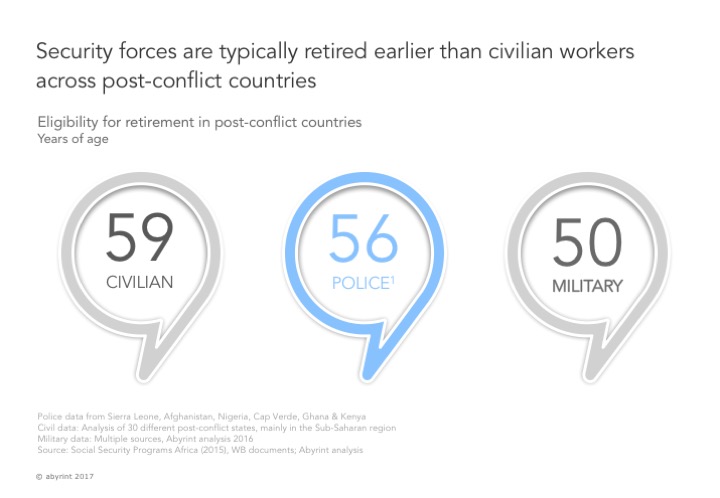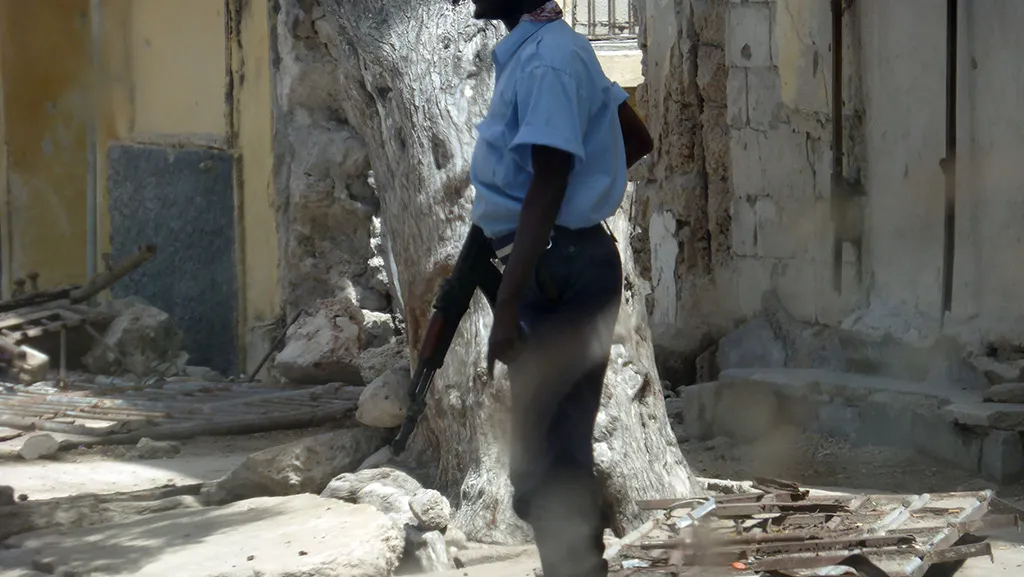Technical Frameworks for Security Sector Demobilization and Payroll Integration
Published on: Tue Aug 15 2017 by Maximillien Von Berg
Conflicts come to an end. Armies need to be demobilized. This is a recurrent situation in fragile environments, a recent example being in the Ivory Coast where discharged soldiers are claiming demobilization compensation.
In other situations, the armies find themselves holding personnel that are not a good fit for the new security architecture: there may be too many, they may be too old, or they may lack the desired skillset.
A combination of factors is often at play in a fragile environment.
All the implications of fragility are visible in security sector reform in post-conflict states. Conflict analysis and fragility study bring out the complexity of reform in unstable environments.
In some situations, this problem is referred to as Disarmament, Demobilization and Reintegration (DDR). This typically focuses on supporting large groups of combatants to reintegrate into civil society. The solution may require restructuring, and it may involve letting some go and recruiting and training other personnel who are a better fit.
Seen from the perspective of the security policy and security sector reform (SSR); the challenges are often linked to optimizing a force structure to better serve the mission objectives, amidst complex politics, tribal, clan and geographical dynamics. The dynamics of fragility and security sector can be extraordinary complex.
Support from the international community is often coupled to other forms of security assistance. The involvement of the international community is complex in itself and cuts across a range of security issues; strategic, tactical, lethal, non-lethal and institutional. All implemented in an unstable fragile environment.
Security sector assistance, perhaps increasingly, also focuses on security governance and institution building. That is, enabling the security institutions to manage themselves. There are many capacity building initiatives in the security sector across the world aimed at this. This also involves strengthening financial and administrative systems of the security sector.
Build a technical roadmap to institution building and financial management in security sector
In this paper, we discuss the implications of taking on demobilization reforms. Demobilization reforms are approached as financial and administrative institution building reforms.
Being cognisant of the particular complexities of the security sector, our contribution is to focus on the administrative, financial and institutional issues. Clients we support need to take on these problems. It involves managing multiple dimensions of technical and political issues, adapted to the realities of a fragile state environment.
We focus on the technical roadmap for these types of reforms. This focuses on both strategy and implementation. It addresses building the required institution building, including the fiscal and financial management arrangements. This is tailored to support reform in an unstable environment. It is written for the leadership and the challenges it faces.
Our starting point is a technical financial management perspective. Security sector expenditures comprise a large share of government finances in fragile and post-conflict countries. Controls are typically weaker and there are less mechanisms in place to ensure effectiveness of public spending.
Reforms of security sector financing often falls outside of the view of traditional public financial management (PFM) reforms. They fall outside of the view of the World Bank and of the IMF. But the core principles of those reforms are also applicable also in the security sector.
Here are some important pointers in that regard.
Exhibit A: Three step demobilisation strategy
[caption id=“attachment_13372” align=“alignnone” width=“720”] Three step demobilisation strategy[/caption]
Three step demobilisation strategy[/caption]
- Eligibility
Who should be eligible for compensation? This is about determining which persons should receive compensation and under which conditions.
- Financing
The financing itself is composed of three components: amount, disbursement method, and budget.
- How much should they be compensated? This is about determining how much compensation eligible persons should receive and under which conditions.
- How to deliver the payments? This is about determining which method should be selected to distribute the amounts they are entitled to eligible persons.
- Where are the financial resources found? This is about identifying the funding source to support the budgeting of the demobilization program.
- Implementation
What mechanisms for the sustainability of the program? This is about determining the structure around the administration of payments from functional, Human Resource, and governance and accountability perspectives.
Step 1. Establish eligibility of security sector personnel
(i) Determine beneficiaries
Following a conflict or war, myriad different contingents of combatants may be present. A non-exhaustive list would include government soldiers, anti-government rebels, local militias, or fighters associated with ethnic or religious groups at the time the fighting ends or when a political agreement is found. Formerly warring combatants will need to remain/integrate with the regular armed forces or be transitioned into civil society and civil jobs as part of a reintegration process. Regardless of individual outcomes, demobilization and reintegration are conditions for peace and stability and must be addressed with care and through consultations.
If armed forces in excess or lacking the required qualifications are identified, demobilization is key. The first challenge is to identify the pool of individuals to demobilize. The identification process may not be straightforward and objective criteria must be agreed upon ex ante, at the political level, to avoid grievances and relapse into conflict. Simple questions will be asked, such as “who should receive financial compensation?”, “how are they identified?”, “where are they located?” and “how can they best be reached?”, etc.
At Abyrint, we have found that lack of appropriate qualifications and age are determinant factors. As shown below, older officers may be overrepresented compared to non-officers. In the case of prolonged conflict, their skills may also be out of date with the requirements of a modern force. This situation is prevalent in areas where prolonged civil wars have durably derailed the national administration of armed forces.
Exhibit B: Age distribution of armed forces personnel encountered in a post conflict environment
[caption id=“attachment_13373” align=“alignnone” width=“720”] Understanding age distribution of personnel[/caption]
Understanding age distribution of personnel[/caption]
Exhibit C: Average retirement ages across post conflict countries
[caption id=“attachment_13384” align=“alignnone” width=“720”] Average retirement ages in post-conflict countries[/caption]
Average retirement ages in post-conflict countries[/caption]
Determining the pool of beneficiaries must be mutually agreed by parties to the political process. This part is complex and must be successful to set robust foundations for a demobilization scheme. It can be particularly difficult as different groups will present differences in ethos (motivations, culture and background), demands (food, cash, shelter, rights, employment), needs (a child soldier vs a senior army general), etc.
(ii) Determine criteria
The criteria for eligibility will determine how the right to receive benefits will be triggered. These must be objective and transparent and will feed into the development of processes and systems for the implementation of demobilization. These can often be levied from existing legislation for the armed forces, which includes provisions on eligibility requirements to receive financial compensation for service in the armed forces. Typically, these include criteria such as:
- years of service
- age
- rank
- particular circumstances (e.g. disabilities, wounded in action, convictions, etc.)
These criteria will vary depending on context and local specificities but the above summarized the main ones. Additional criteria may determine whether rights are passed on to a next of kin in case of death of the beneficiary. This can take place where a demobilized ex-combatant passes away leaving a family behind with no other source of income. The demobilization stipend provides a safety net for relatives.
A stipend is a form of steady income – or a social benefit –, which can act as a buffer against conflict resurgence. Addison and McGillivray found that supporting livelihoods in the immediate aftermath of conflict reduces conflict resurgence.[i] The important part is to alter the cost-benefit of conflict, where transparent compensation criteria and mechanisms are part of the solution for peace. Stipends can stabilize fragile environments.
Step 2. Resolve fiscal and financial issues of demobilisation and retirement of security forces
(i) Modalities for payments
The financing impacts strategic considerations by exercising a constraint on amounts and options available to the government.
- Should benefits be paid as a lump sum on one occasion or on a recurrent basis, such as monthly instalments?
- Should benefits be paid in cash or in kind?
- Do beneficiaries need a bank account? A mobile money account?
(a) A lump-sum ‘one off’ payment will have a higher initial capital requirement
Lump sum payments have the advantage of putting an end to state obligations towards ex-combatants and provide a boost to the economy. However, they also increase the immediate burden on public finances, risk upsetting the local economy such as by creating inflation or imbalances, and may stabilize society less as no future gains are to be expected from the government.
On the long-term, it may therefore not increase government legitimacy. On the other hand, a recurrent scheme only provides small instalments for beneficiaries, which do not allow for much investment to be made. Nevertheless, such a scheme incentivizes the participation in maintaining peace and supporting the administration.
Exhibit D: Modality of demobilization compensation distribution
[caption id=“attachment_13375” align=“alignnone” width=“720”] Payment concepts for demobilisation[/caption]
Payment concepts for demobilisation[/caption]
(ii) A recurrent scheme
Pension schemes can be structured around a ‘pay-in’ mechanism or ‘pay-as-you-go’ mechanism. Most pension systems will follow the latter mechanism where beneficiaries will have transferred part of their earnings iteratively over a given period of time. This scheme is also more likely in contexts of weak governance where the population’s trust in the government and state authorities is limited and long-term planning less trustworthy.
Other governments with high liquidity may be able to adopt a pay-in mechanism where the government sets aside the necessary amount to pay for retirees’ pensions. This can take place under the form of a pension fund.
In states where prolonged periods of conflict have affected the administration’s ability to function, former compensation policies may be outdated or unacceptable to parties. We suggest benchmarking against frameworks applied in comparable states or situations. One metric to look for is the average monthly pay of combatants in similar polities. This allows to estimate how much ex-combatants or retiring combatants would expect to sustain themselves in an acceptable way. We tend to divide combatants between officers and non-officers. The figures must then be appreciated with respect to GDP per capita and adapted accordingly.
Exhibit E: Monthly compensation per armed type of personnel excluding rations in USD

When ex-combatants are identified as eligible to receive compensation to demobilize or retire, benchmarking benefits against other polities is helpful in the absence of an existing national scheme or if the old order is no longer acceptable. We identified benefits distributed in lower income developing countries as hovering around 30% of the last received salary.
Exhibit F: Retirement benefit as a share of last monthly salary in USD

(ii) Budget and fiscal planning
Demobilization will typically require an immediate cost and a differed cost. The immediate cost is likely to be relatively large as many ex-combatants are to be retired from active duty or persuaded to surrender their weapons. However, the net present value (NPV) of the cost of retirement will be lower. In other words, investing now in demobilization stipends to retire persons is lower than the future cost of supporting them on payroll. Funding pensions today may thus offer a positive NPV even though the cost may seem relatively high.
In contexts where fighting was prolonged, occasionally lasting more than a decade, demobilization will include many retirees eligible for a pension. In cases of prolonged war, a significant share of active combatants may be above the age of retirement – typically 50-55 years of age in the armed forces, depending on country and rank. Post conflict environments will most likely suffer from strained resources and only a ‘pay-as-you-go’ type of scheme will be possible, as the government does not possess enough liquidity to fund pensions in full.
Emergence from conflict may also be the opportunity to retire older armed forces personnel to reduce the weight of the wage bill in the medium run and favour rejuvenation in the armed forces. The logical next step is to design a plan for the reintegration of ex-combatants in the economy via vocational trainings, placements and skills development. An example extracted from real data is presented below and depicts the initial large number of persons retiring in year one.
Exhibit G: Number of new retirees over time by year

Variance in the cost of demobilization and retirement can be high. The figures presented above are only indicative but can be used to narrow down the window of a reasonable lump sum payment for ex-combatants to lay down their weapons without lingering grievances.
Developing nations often see much public expenditure funnelled into salaries in the public sector, which then constrains developing governments in the use of funds required for development. Wage bills hover around 24-25% of government budget for advanced economies, whereas this figure tends to be higher in low income developing countries.[i] In fragile states, the wage bill may be even larger and harrow around the 50% mark. The wage bill is a particularly important metric in low income developing countries where capital available to government is already scarce. In the example showcased below, an initial financial effort upfront would lead to the reduction of 15% of the wage bill. The larger the wage bill, the less available funds a government holds to carry out reforms and development.
Exhibit H: Reduction in the wage bill per year in millions USD

The timeline between the end of fighting and the implementation of a full-fledged demobilization compensation administered competently and transparently tends to take place over several years. Historical case studies suggest it has taken a decade in some countries to have such scheme running, thereby increasing the risk of relapse into conflict in the meantime. This reality stresses the importance of implementing a transparent, agreeable and efficient demobilization compensation scheme. The effort will typically involve the Ministry of Finance, the Ministry of Defence, possibly the Ministry of Interior, representatives of previously warring groups, as well as the Central Bank.
Step 3. Build implementation mechanisms for a demobilisation and retirement scheme
The implementation of a demobilization compensation scheme for ex-combatants is of great importance to ensure transparency, economic opportunity, and social and political stability. It is a non-negligible part of Public Financial Management (PFM) in post-conflict states.
While most development approaches target up-stream and de jure activities in rebuilding states, in the context of a demobilization and retirement situation, it is essential to focus on de facto and downstream activities to deliver financial compensation. Implementing a payroll system and payment process backed by robust technology may happen before legislation is passed in the National Parliament. Civil servants may need to undergo quick training on PFM principles to abide to international standards in administering registries and payroll.
To avoid risking a fragile peace upon administering recently demobilized combatants, government agencies – via the Ministry of Finance – can manage registries with support of the Ministry of Defence or other relevant government agencies. They should operate with legislative backing – to the extent possible – and supported by systems as early as possible.
The governance structure around financial disbursements is a sensitive area. To reduce risk in cases of a fragile political peace, Paul Collier argues the presence of an international ‘neutral’ military force (generally the UN blue helmets) can reduce the security and stability risks.[i]
Similarly, having a World Bank-commissioned Monitoring Agent can also defuse tension by providing neutrality in the financial process. A Monitoring Agent also reduces fiduciary risk for development partners and enhances the credibility of the recipient Government when soundly executed.
Exhibit I: Four areas of capacity to consider when building a demobilisation program

The implementation of systems and technology should be done by neutral actors and the administration of stipends and pensions grounded in systems characterized by integrity and processes compliant with segregation of duties. The administrator of stipends can either be part of a Government entity or be outsourced to an external body. The key is to delegate this responsibility to a capable team, which constitutes an inherent ‘capacity-building’ part of any change management project. Processes and technology solutions will also require implementation to activate payments.
Ultimately, eligibility, financing and implementation are building blocks for peace and social and economic progress. They are part of a de-risking strategy coming out of a conflict. They take time, but they are crucial.
Exhibit J: The building blocks of demobilization over time

Successful demobilization and transparent compensation mechanisms increase Government legitimacy, both nationally and internationally. They advance the Government’s credibility as a trustworthy partner for the international community and pave the way to institutional reform.
At Abyrint we have worked much with reforming security sector finance. This is foundational for security sector reforms in fragile states.
[i] Collier, Paul. “Post-conflict Recovery: How Should Strategies Be Distinctive? Journal of African Economies, Volume 18, 2009, pp. 99–131
[i] Curristine, Teresa and Mercedes Garcia-Escribano. “Managing Government Wages and Employment,” Public Financial Management Blog, IMF, September 21, 2016. http://blog-pfm.imf.org/pfmblog/2016/09/managing-government-wage-and-employment.html
[i] Addison, Tony and Mark McGillivray. “Aid to conflict‐affected countries: lessons for donors.” Conflict, Security and Development, Volume 4, Issue 3, 2004. p. 347-367
Maximilien Von Berg @abyrint



